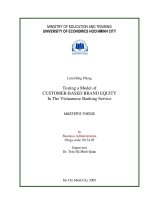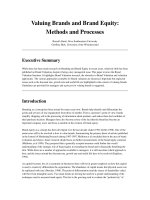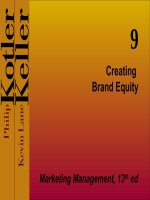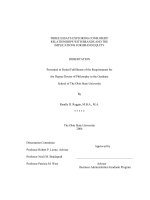Product brand equity
Bạn đang xem bản rút gọn của tài liệu. Xem và tải ngay bản đầy đủ của tài liệu tại đây (4.19 MB, 62 trang )
Lecture 6:
Product, Service,
and Branding
Definition of products
Layers of product
Types of products
Outline
Product line and product mix
Product portfolio managment decisions
Service definition & characteristics
Service Marketing Tasks
Lectured by Khoa Nguyen
What is a
product?
Lectured by Khoa Nguyen
Definition
of Product
• A product is anything that can be
offered to a market for attention,
acquisition, use, or consumption that
might satisfy a want or need.
• Broadly defined, “products” also include
services, events, persons, places,
organizations, ideas, or mixes of these.
An MSG company, i.e. Ajinomoto,
decided to sell coffee to the Vietnamese
market. Question: how Ajinomoto
acquires attention from customers?
Lectured by Khoa Nguyen
Value-based prices
Components of the
Market Offering
Attractiveness
of the market
offering
Product
features
and quality
Lectured by Khoa Nguyen
Services
mix and
quality
Five product levels
Lectured by Khoa Nguyen
Classfication Of Products
Lectured by Khoa Nguyen
Industrial
products
Types of Product?
Consumer
products
Lectured by Khoa Nguyen
Convenience
Shopping
Specialty
Unsought
Consumer
Goods
Classification
Convenience
Product
• …Customers usually buy frequently,
immediately, and with a minimum of
comparison and buying effort.
Lectured by Khoa Nguyen
• less frequently purchased
• customers compare carefully on suitability,
quality, price, and style
Specialty Product
• Unique characteristics or brand
identification
• Buyers are willing to make a special
purchase effort.
Lectured by Khoa Nguyen
Unsought Product
• …consumer either does not know
about or knows about but does not
normally think of buying.
Lectured by Khoa Nguyen
Industrial
Products
• Industrial products are those
purchased for further processing or for
use in conducting a business,
including:
• Materials and parts
• Capital items
• Supplies and services.
Lectured by Khoa Nguyen
Raw
Materials/Parts
Lectured by Khoa Nguyen
Capital
Items
Lectured by Khoa Nguyen
Supplies/Services
Lectured by Khoa Nguyen
Test your
knowledge
• Which of the following are examples of
shopping products?
• A. Furniture, clothing, used cars, major
appliances, and hotel and airline services
• B. Laundry detergent, candy, magazines,
and fast food
• C. Branded cars, high-priced photographic
equipment, and designer clothes
• D. Life insurance, preplanned funeral
services, and blood donations to the Red
Cross
Lectured by Khoa Nguyen
Test your
knowledge
• Which of the following are examples of
shopping products?
• A. Furniture, clothing, used cars, major
appliances, and hotel and airline services
• B. Laundry detergent, candy, magazines,
and fast food
• C. Branded cars, high-priced photographic
equipment, and designer clothes
• D. Life insurance, preplanned funeral
services, and blood donations to the Red
Cross
Lectured by Khoa Nguyen
Product
Differentiation
• Product form
• Features
• Customization
• Performance
• Conformance
• Durability
• Reliability
• Repairability
• Style
Product Line &
Product Mix
Lectured by Khoa Nguyen
Product Line
• Product line is a group of products that are closely related
because they function in a similar manner, are sold to the same
customer groups, are marketed through the same types of
outlets, or fall within given price ranges
• Product line length is the number of items in the product line.
Lectured by Khoa Nguyen
Product line filling.
Product Line
Decisions
Product line stretching.
Lectured by Khoa Nguyen
Product
Mix
• Product mix consists of
all the products and
items that a particular
seller offers for sale.
• Also called: Product
poftfolio
• A company’s product
mix has four dimensions:
width, length, depth,
and consistency.
Lectured by Khoa Nguyen
Four dimensions
of product mix
• Product mix width refers to the number of
different product lines the company carries.
• Product mix length refers to the total number
of items the company carries within its
product lines.
• Product mix depth refers to the number of
versions offered of each product in the line.
• Product mix consistency refers to how
closely related the various product lines are in
end use, production requirements, distribution
channels, or some other way.
Lectured by Khoa Nguyen









